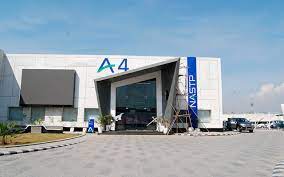M Z Faisal
It is said that seeing is believing, and rightly so. Words cannot replicate my incredibly inspiring and reassuring visit to the National Aerospace Science & Technology Park (NASTP) Alpha at PAF Base Nur Khan. Despite spending hours, the entire charismatic splendour of NASTP Alpha couldn’t be captured. It was one of my retired life’s most rewarding and memorable moments. In these testing times, this visit provided a glimmer of hope and optimism that I feel compelled to share to boost national spirits and reinvigorate a much-needed sense of hope.
The PAF is renowned for its young, dynamic leadership undertaking innovative, bold and futuristic projects. The NASTP is one such excellent initiative of strategic national importance conceived and spearheaded by the Chief of the Air Staff ACM Zaheer Ahmed Baber Sidhu. Its main objective is to create an innovation ecosystem nationwide, bringing together industry, academia, and the armed forces to strengthen the PAF by advancing the local aerospace industry.
On the broader canvas, NASTP Kamra is the flagship Headquarter encompassing “Design, R&D, manufacturing, Product Lifecycle Management (PLM), Training, Maintenance / Repair/ Overhaul (MRO), Aviation Logistics, along with global supply chains of strategic industries like Aerospace, IT and Computing”. NASTP Kamra is then connected to three regional NASTP centres at Rawalpindi, Lahore and Karachi that would “create regional level eco-systems to be ultimately connected at the national level with NASTP Kamra”. To put it simply, NASTP is a comprehensive initiative aimed at assembling the most brilliant minds, cutting-edge technologies, and diverse experiences to develop and transform futuristic concepts for the aerospace industry in collaboration with national and international partners.
Future wars will be fought in black and white, but much will also be fought in the grey zone. Non-kinetic methods of warfare, such as electronic warfare, cyber-attacks, artificial intelligence, and quantum computing, will be significant game-changers, tipping the scales against adversaries. Securing superiority in space will be crucial for both offensive and defensive operations. Unmanned Aerial Vehicles (UAVs) powered by sophisticated Artificial Intelligence (AI) will be lethal and give a new balance between qualitative edge and quantitative depth. With emerging technologies rapidly reshaping the future and making current operational concepts obsolete, the NASTP is a world-class setup, intelligently designed and artistically furbished to explore and harness the potential of such game-changing technologies. It is perhaps the largest design and R&D setup of the Pakistan Air Force in “Aircraft, Space, Radar, Wireless and Communications Systems, Simulators, Cyber, IT, Computing & Big Data, Software Development, and Artificial Intelligence domains”.
It was heartening to note the Turkish Aircraft Industry (TAI), known for aircraft manufacturing, and leading Turkish UAV company ‘Baykar’, best known for its TB2 and Akinci drones, set up their offices in NASTP. This strategic collaboration holds great promise for both nations. Expanding on the experience of JF-17 and deepening defence ties with Turkey, PAF is currently working on another fighter program called ‘PFX’. The program is in the advanced design stage and will incorporate all futuristic capabilities being developed at different NASTP centres. Already, the PAF 4.5 Gen J-10C, with the advanced avionic package, is ahead of its rival, the Rafale, and when the time comes, it could surprise the formidable S-400 with few undisclosed weapons.
It was deeply inspiring to physically find in the NASTP the PAF’s recently inducted Turkish and Chinese drones and UCAVs in the Medium-Altitude Long Endurance (MALE) and High-Altitude Long Endurance (HALE) categories, some of which have already demonstrated their combat worthiness in the Azerbaijan-Armenia and Russian-Ukraine conflicts. These drones and UCAVs are the present and the future of modern warfare and shall deeply augment the offensive punch of PAF in kinetic and non-kinetic roles. These can be of great operational efficacy against the fresh hybrid war being fought along the border regions of Pakistan. Another indigenous invention of particular interest was the low-cost airborne loitering munition, which can autonomously engage any high-value target with precision. A barrage of fire can unleash a deadly rain of destruction from the sky.
The Pakistan Air Force (PAF) is acutely aware of the increasing gap with India in the space domain and has developed an effective strategy to deny India any offensive space advantage in the event of a contingency. The PAF’s exceptional focus on cyber warfare, electronic warfare (EW), and quantum computing from offensive and defensive perspectives is praiseworthy. These advanced capabilities, particularly in the domains of EW and cyber warfare, can cause significant damage to adversary by disrupting and destroying command and control systems, satellite networks, tactical data links, missile guidance systems, avionics, targeting pods, and other critical systems.
Pakistan’s aerospace industry is set to receive a major boost with the inception of the NASTP. The project will fortify the country’s aerospace sector, boost economic growth, and augment Pakistan’s reputation globally. ACM Zaheer Ahmed Baber Sidhu and the entire PAF leadership deserve commendation for their foresight in conceiving a project of immense national significance and multiple strategic dividends.
The writer is the Director of Warfare and Aerospace at the Centre for Aerospace and Security Studies (CASS), Lahore, Pakistan. He can be reached at casslahore@gmail.com







